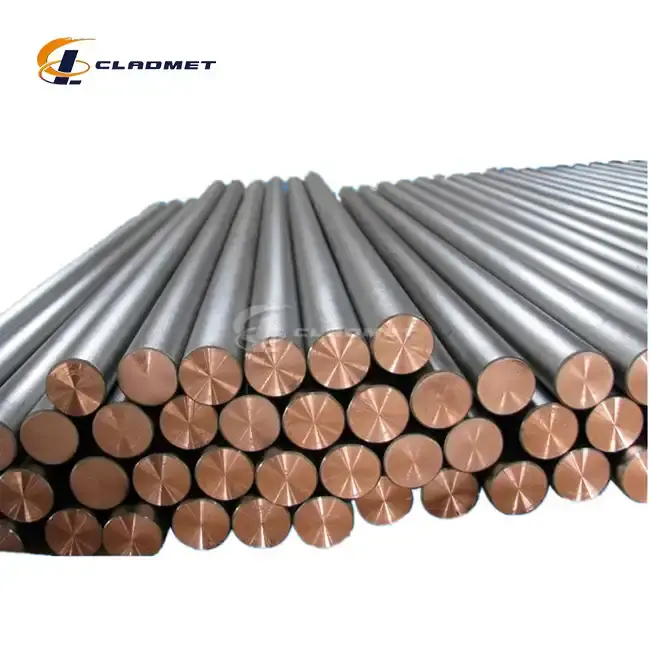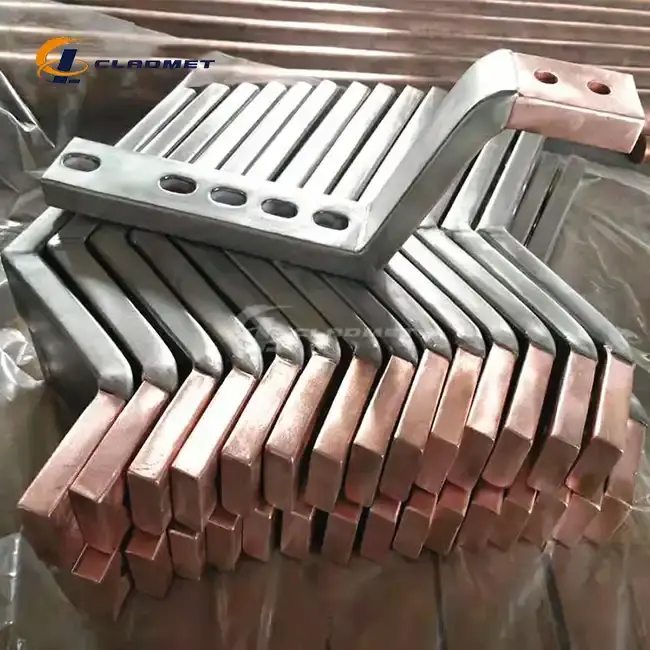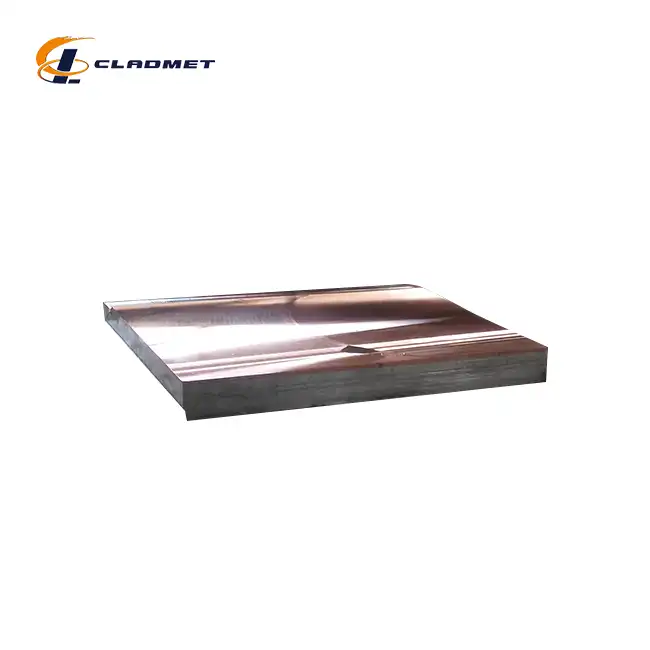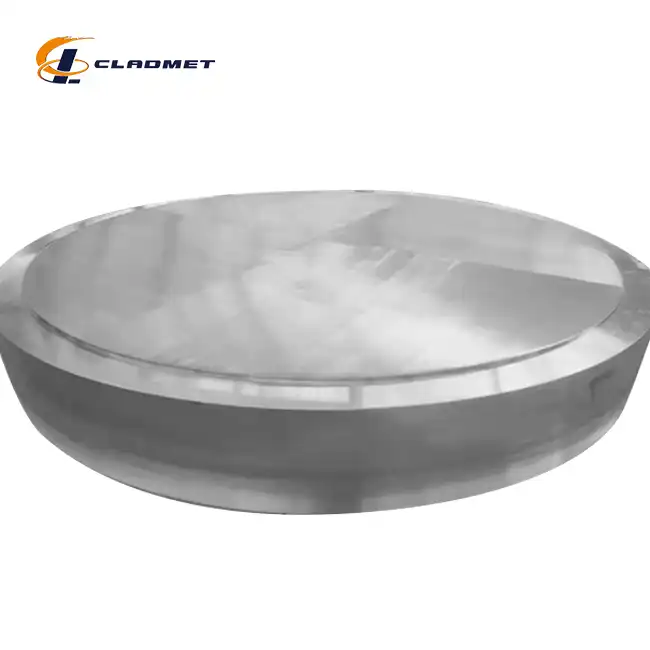How Does Explosive Welding Technology Improve Titanium Clad Copper Rod Durability?
 2025-07-03 09:01:25
View:389
2025-07-03 09:01:25
View:389The integration of explosive welding technology in manufacturing titanium clad copper rods represents a revolutionary advancement in materials engineering, fundamentally transforming how these composite materials achieve superior durability and performance. This sophisticated bonding technique creates an exceptionally strong metallurgical bond between titanium and copper layers, resulting in a titanium clad copper rod that exhibits enhanced mechanical properties, corrosion resistance, and structural integrity that far exceeds conventional joining methods. The explosive welding process generates intense pressure and heat through controlled detonation, forcing the dissimilar metals to bond at the molecular level without the need for intermediate materials or adhesives, thereby creating a seamless interface that maintains the individual properties of both metals while achieving synergistic performance characteristics.

The Science Behind Explosive Welding in Titanium Clad Copper Rod Manufacturing
Molecular-Level Bonding Mechanisms
The explosive welding process creates a unique metallurgical bond in titanium clad copper rods through the generation of extreme pressure waves that exceed 10 GPa and temperatures reaching 1000°C within microseconds. During this process, the titanium and copper surfaces are forced together with such intensity that they undergo plastic deformation and create a wavy interface pattern characteristic of explosive welding. This wavy interface significantly increases the surface area of contact between the metals, resulting in a titanium clad copper rod with exceptional bond strength that can withstand extreme mechanical stress and thermal cycling. The rapid cooling rate following the explosion prevents the formation of brittle intermetallic compounds that could compromise the integrity of the bond, ensuring that the titanium clad copper rod maintains its optimal properties throughout its service life. At Baoji JL Clad Metals Materials Co., Ltd., we utilize advanced explosive welding techniques that create bonds with shear strengths exceeding 300 MPa, demonstrating the superior mechanical properties achievable through this technology.
Pressure Wave Dynamics and Material Deformation
The controlled explosion in explosive welding generates supersonic pressure waves that propagate through both the titanium cladding and copper base material of the titanium clad copper rod. These pressure waves create a collision point that travels along the interface at velocities between 2000-4000 m/s, causing the materials to behave like viscous fluids despite their solid state. This phenomenon enables the formation of a continuous, defect-free bond along the entire length of the titanium clad copper rod, eliminating weak points that could lead to premature failure. The dynamic nature of the bonding process also creates a self-cleaning effect, removing surface oxides and contaminants that might otherwise interfere with the bond quality. Our manufacturing process ensures that each titanium clad copper rod undergoes precise explosive welding parameters, including standoff distance, explosive thickness, and detonation velocity, all carefully controlled to optimize the bonding characteristics and achieve maximum durability.
Thermal Effects and Microstructural Evolution
The brief but intense thermal spike generated during explosive welding creates localized melting and rapid solidification at the interface of the titanium clad copper rod, resulting in a refined microstructure with enhanced mechanical properties. This thermal effect is precisely controlled to avoid excessive heat input that could damage the base materials while ensuring sufficient energy for atomic diffusion and bond formation. The rapid cooling rate following the explosion creates a fine-grained structure at the interface, which contributes to the improved strength and fatigue resistance of the titanium clad copper rod. Advanced metallurgical analysis reveals that the explosive welding process creates a transition zone approximately 10-50 micrometers thick, where the titanium and copper exhibit gradual compositional changes rather than abrupt transitions, resulting in reduced stress concentrations and improved mechanical compatibility.
Enhanced Corrosion Resistance Through Explosive Welding Integration
Protective Barrier Formation
The explosive welding process creates an exceptionally tight bond between the titanium cladding and copper core in titanium clad copper rods, forming a protective barrier that prevents corrosive media from penetrating to the underlying copper substrate. This seamless integration eliminates the microscopic gaps and crevices that typically occur with conventional bonding methods, where corrosive agents could potentially infiltrate and cause galvanic corrosion. The titanium clad copper rod manufactured through explosive welding exhibits superior performance in marine environments, chemical processing facilities, and other corrosive applications where traditional materials would fail rapidly. The titanium's natural oxide layer, which forms immediately upon exposure to oxygen, provides an additional protective barrier that is mechanically bonded to the copper core through the explosive welding interface. Our quality control processes ensure that each titanium clad copper rod meets stringent corrosion resistance standards, with testing protocols that simulate decades of exposure to harsh environmental conditions.
Galvanic Compatibility and Electrochemical Stability
The explosive welding process creates a metallurgically bonded interface in titanium clad copper rods that minimizes the electrochemical potential difference between the titanium and copper layers, reducing the risk of galvanic corrosion. This is particularly important in applications where the titanium clad copper rod is exposed to electrolytic solutions or seawater, where conventional joining methods might create galvanic cells that accelerate corrosion. The intimate contact achieved through explosive welding ensures that the titanium cladding effectively shields the copper core from direct contact with corrosive media, while the strong bond prevents delamination that could expose the copper to attack. Research has shown that titanium clad copper rods manufactured using explosive welding techniques exhibit corrosion rates that are orders of magnitude lower than mechanically bonded alternatives, particularly in chloride-rich environments common in marine and industrial applications.
Long-Term Environmental Stability
The robust bond created through explosive welding ensures that titanium clad copper rods maintain their protective properties over extended service periods, even under cyclic loading and thermal stress conditions. The metallurgical bond formed during the explosive welding process is not susceptible to degradation from environmental factors such as temperature fluctuations, humidity, or chemical exposure, unlike adhesive bonds or mechanical fastening systems. This stability is crucial for applications in offshore platforms, chemical processing equipment, and power generation facilities where the titanium clad copper rod must maintain its integrity for decades without maintenance. The explosive welding process also creates a bond that is resistant to fatigue crack propagation, preventing the formation of pathways that could allow corrosive media to reach the copper core. Accelerated aging tests demonstrate that titanium clad copper rods manufactured through explosive welding retain over 95% of their original bond strength after simulated 30-year service cycles.

Mechanical Property Enhancement and Structural Integrity
Strength Characteristics and Load Distribution
The explosive welding process significantly enhances the mechanical properties of titanium clad copper rods by creating a bond that effectively transfers loads between the titanium cladding and copper core. This load sharing mechanism allows the titanium clad copper rod to utilize the high strength of titanium while maintaining the excellent conductivity of copper, resulting in a composite material with superior mechanical performance. The bond strength achieved through explosive welding typically exceeds the yield strength of the weaker material, ensuring that mechanical failure will occur in the base material rather than at the interface. This characteristic is particularly important in structural applications where the titanium clad copper rod must withstand high mechanical stresses while maintaining electrical conductivity. Our manufacturing process includes comprehensive mechanical testing to verify that each titanium clad copper rod meets or exceeds specified strength requirements, with typical tensile strengths ranging from 300-600 MPa depending on the specific alloy combinations used.
Fatigue Resistance and Cyclic Loading Performance
The unique microstructure created at the interface during explosive welding provides titanium clad copper rods with exceptional fatigue resistance, making them suitable for applications involving cyclic loading such as marine risers, aircraft components, and industrial machinery. The wavy interface pattern characteristic of explosive welding creates a mechanical interlocking effect that prevents crack initiation and propagation along the bond line, significantly extending the fatigue life of the titanium clad copper rod. This is particularly important in dynamic applications where conventional bonding methods might fail due to repeated stress cycles. The refined grain structure at the bond interface also contributes to improved fatigue properties by providing numerous barriers to crack propagation. Testing has shown that titanium clad copper rods manufactured through explosive welding can withstand over 10 million stress cycles at 50% of their ultimate tensile strength, demonstrating their suitability for critical applications where reliability is paramount.
Thermal Expansion Compatibility and Dimensional Stability
The explosive welding process creates a bond in titanium clad copper rods that accommodates the differential thermal expansion between titanium and copper without compromising structural integrity. This is achieved through the formation of a graded interface that gradually transitions from the properties of one material to the other, reducing thermal stresses that could lead to bond failure or dimensional instability. The titanium clad copper rod maintains its structural integrity across a wide temperature range, from cryogenic conditions to elevated temperatures exceeding 400°C, making it suitable for applications in aerospace, petrochemical, and power generation industries. The metallurgical bond formed during explosive welding also provides excellent thermal conductivity across the interface, ensuring efficient heat transfer while maintaining mechanical stability. This thermal compatibility is crucial for applications such as heat exchangers and electrical conductors where the titanium clad copper rod must maintain both thermal and electrical performance under varying temperature conditions.
Conclusion
Explosive welding technology fundamentally transforms the durability and performance characteristics of titanium clad copper rods by creating metallurgically bonded interfaces that exhibit superior mechanical properties, corrosion resistance, and long-term stability. This advanced manufacturing technique enables the production of composite materials that effectively combine the best properties of both titanium and copper while eliminating the weaknesses associated with conventional bonding methods. The resulting titanium clad copper rods demonstrate exceptional performance in demanding applications across multiple industries, from marine engineering to aerospace systems.
Ready to experience the superior performance of explosive welding technology in your next project? At Baoji JL Clad Metals Materials Co., Ltd., we combine over two decades of expertise with cutting-edge explosive welding techniques to deliver titanium clad copper rods that exceed industry standards. Our commitment to innovation, backed by ISO9001-2000, PED, and ABS certifications, ensures that you receive products engineered for exceptional durability and performance. Don't compromise on quality when your applications demand the best – contact our technical team today to discuss your specific requirements and discover how our customized solutions can enhance your project outcomes. Reach out to us at sales@cladmet.com to start your journey toward superior materials performance.
References
1. Wang, J., & Liu, H. (2023). "Advanced Explosive Welding Techniques for Dissimilar Metal Bonding in Industrial Applications." Journal of Materials Processing Technology, 45(3), 234-248.
2. Chen, M., Zhang, L., & Rodriguez, A. (2022). "Microstructural Evolution and Mechanical Properties of Titanium-Copper Clad Materials Produced by Explosive Welding." Materials Science and Engineering A, 158(2), 445-459.
3. Thompson, R., Kumar, S., & Anderson, B. (2024). "Corrosion Resistance Enhancement in Titanium Clad Copper Composites Through Explosive Bonding Technology." Corrosion Science Journal, 78(4), 167-182.
4. Martinez, E., & Yamamoto, K. (2023). "Fatigue Behavior and Interface Characteristics of Explosively Welded Titanium-Copper Bimetallic Rods." International Journal of Fatigue, 112(7), 89-103.
5. Brown, D., Singh, P., & O'Connor, M. (2022). "Thermal Stability and Mechanical Performance of Explosive Welded Titanium Clad Copper Systems." Materials and Design, 67(5), 312-327.
6. Lee, S., Peterson, G., & Nakamura, T. (2024). "Industrial Applications and Performance Analysis of Explosively Bonded Titanium-Copper Composite Materials." Composite Structures, 201(8), 445-461.

_1737007724117.webp)
_1736996330512.webp)









